The artist's becoming the preferred role model of modern Europe is a perfectly understandable process, as we can see in him the embodiment of the idea of individuality and, ultimately, human dignity. However, detaching ourselves from the aura—thus also from the promise associated with this figure—we see a strange, even dark question emerging. What if this promise can't be kept, and what if we’re now confronting the figure of the failed artist? This is a thought that the American philosopher Eric Hoffer made, in the early 1950s, the core of his work The True Believer – in which he argues that totalitarianism, as it raged in its Nazi and Stalinist varieties, could first and foremost be counted as failed artists. And this is precisely the idea of artist Megan Gafford, who sees the disappearance of beauty—exemplified by Marcel Duchamp's urinal—as one of the great catastrophes of the last century. Because what art denies itself seeks refuge in political activism. Since Megan Gafford, who taught design and drawing at the University of Denver and has been teaching at the University of Boulder for more than a decade, has been able to observe this logic of mobilization at close range, she's emerged as a journalistic voice with this idea, writing for magazines such as Quillette, Areo, and Tilt West.
Megan Gafford is an artist who lives and teaches in New York. Her interest in science and technology drives her artwork's strange sense of uncanniness. In her studio practice, she repurposes unsettling scientific tools like radiation and cybernetics as art materials, to create work that commingles eeriness and elegance. She also has a Substack blog called Fashionably Late Takes.
Recent Articles:
The Totalitarian Artist: Politics vs Beauty. In Quillette
and Megan Gafford recommends
Samuel Hughes: The Beauty of Concrete
Related Content
As Dalí started dreaming of WALL-E
Why a self-experiment with DALL-E? Perhaps because life is life-sized, and the clearest view of a thing comes from not owing any thing to secondary sources – only our own experiences. DALL-E’s quickly explained as the visual application of OpenAI. However, having acquired a particularly dark notoriety in the form of
Life in the Attention Economy
What makes Quota is the second text in our new series of Martin Burckhardt’s later writings. First appearing in the December 2017 issue of Merkur, this essay falls between 2015’s Alles und Nichts:Ein Pandämonium digitaler Weltvernichtung and 2018’s Philosophie der Maschine























Share this post